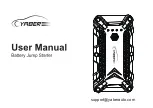
AnAtomy of A rAdio
4
RotorDroneMag.com
Airborne System
The little electronic box that “hears” the signal sent to it by the transmitter
is called the receiver. Its job is to receive the radio signal, translate it into the
desired flight commands, and then convert it back into the proper signals to
move the various servos and provide the rotors’ speed information to the flight
motors. Most of today’s RC radio systems operate on the 2.4GHz frequency
band and for the transmitter and receiver to work together, you have to “bind”
or link the receiver to your particular transmitter. Once this is done, the receiver
will only accept the specific coded signals sent to it by the linked transmitter.
This type of signal modulation
completely eliminates any change
of radio interference from other RC
transmitters operating in the same
area.
The receiver can be powered
by a separate battery pack or by
an electronic speed control that is
equipped with electronic circuitry
that provides power to the receiver
and servos from the main battery.
Sub-menu
Screens
Once you enter the radio’s
programming menus, you can
call out and select several sub-
menus, where you can enter your
changes and selections. Some of
the basic sub-menus include those
for setting up the various servos
for control throw and direction as
well as sub-trims for fine-tuning
the center point of the servo.
You can also adjust control rates and the sensitivity around the center of the
control stick movements. There are sub-menus for selecting the model type,
which gives you the choice of airplane, glider/sailplane, helicopter, and with the
Futaba 10J, multirotor programming. Like any other type of advanced electronic
device, programming your RC transmitter becomes easier with continued use
–- and watching multiple YouTube videos! With increased experience comes a
better understanding of what’s possible.
K
transMitter case
On the back side of the
case there is the battery
compartment cover, the Trainer
“Buddy Box” connection jack,
a 3.5mm earphone plug for
listening to telemetry data
and an S.Bus connector for
advanced servo and telemetry
module setup.
Right: The main display shows you all the sub-menus so
you can make the required adjustments. Here you see
two of the specialty S.Bus receiver setting screens.
Below: There are many brands of transmitter and
radio systems available with various options and with
different numbers of channels.
The receiver will only
accept the specific
coded signals sent
to it by its linked
transmitter.





















